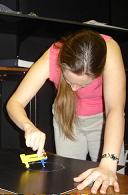The moral of today: One measurement is not a measurement. Practically the only two things I can do is to build the stimulator circuit and get an other photometer to make sure it’s not a calibration artifact. Then, all I can do is wash my hands how Pontius Pilate did. Then, I have locked out all possibility to have a misconducted measurement, and then, I can say is that my measurement is indeed correct no matter how wacky and unrealistic it seems. So the question is now if I have something publishable or more modest. Two weeks to go.
Yearly Archives: 2013
Proud PI
We just hosted a lab tour of shortlisted applicants to Newcastle’s Wellcome-Trust-funded 4-year neuroscience PhD theme. We only had half an hour, but in this time Paul, James, Zoltan, Parto and Lisa each gave a dynamic and lucid summary of their work, its motivation and important, and showed off their stimuli / insects / smartphones (delete as appropriate). On the way out one of the applicants said to me, “And what do YOU do?” I just waved a hand airily and said, “Oh, I supervise, you know…” Frankly with this team I’m fairly redundant but I like to think I look decorative.
Zoltan’s diary: Thursday 14/03/2013
The weird result I am seeing is not caused by the monitor. Also, it is not caused by the different refresh rate and stabilised plate current. I am getting the same things over and over again, and the test show that there is a significant deviation to what I was expecting. I can’t think of any other thing I might have missed, and the results are pretty consistent. I currently have 10 matlab figures open and can see the same pattern over and over again. Okay, the coefficients are different, but the other monitor is brighter, smaller and behaves differently.
To do an other verification, I will make a circuit, and will check it with LEDs as well. This tendency should vanish.
Zoltan’s diary: Tuesday 12/03/2013
Do you know what is the answer to the ultimate question of life, the universe and everything? If you say 42, well, you are at least as much of a nerd as I am.
I think I found today the psychophysics equivalent of it: 1.4142136. I don’t want to jump into conclusions, so I am doing extra verification, replacing displays, redoing experiments, so I can be a hundred zillion percent sure that it’s not there because I forgot something. Guess I will find out in the next few days.
Also, I had my arm zapped for a good 20 minutes. Georgia was astonished how fast I found the nerve in my arm to test a reflex. Weird.
Zoltan’s diary: Monday 11/03/2013
Spent pretty much all day playing with Matlab. I have my experiment done (it works, verified), I also have my initial result processing script done (which also works, I verified it). What I don’t understand is why things go haywire when I sort the final array. As usual, I sort by the first column, but this time it seems that it doesn’t keep the rows. Anyway, I could get around it eventually, but it’s strange…
I also think I found an artifact in the results. Will need to replace the monitor to see if it’s real.
Zoltan’s diary: 08/03/2013
Got more results today. I see people getting bored with the experiment. For instance, my arm will be zapped for two hours in exchange for an experiment. But also it includes the more generous spreading of chocolate, teas, etc.
I have a theory on how we should mathematise the findings, we’ll see if it stands…
Zoltan’s diary: Thursday 07/03/2013
Had meetings almost all day. Still managed to add more functionality to processing and do some more experiments. More will follow tomorrow.
Zoltan’s diary: Wednesday 06/03/2013
What makes you an engineer? Not the degree. Not the experience. And especially not the ability to fix things.
What makes you an engineer is exercising and understanding the concept of healthy technical laziness.
Healthy technical laziness is not general laziness. This does not describe one’s productivity and work ethics at all.
If an individual thinks about how to reduce the number of manual interventions in a process, the individual exercises healthy technical laziness. This is done for the sake of allowing more time for doing something useful.
Want an example? Remember that video when someone wrote a shell script to rock a cradle? The baby seemed to like it!
(http://www.youtube.com/watch?v=bYcF_xX2DE8)
This is, in essence, healthy technical laziness.
With a little bit more thinking, using adaptive design, it is possible to automatise a number of tasks. What computers do best (apart from heating the room, thereby pleasing cats) is number crunching. In fact, this is the only thing they can do. We correspond numbers to luminance, colour, amplitude, keystrokes…
So, I figured I would rather spend some time on how to process the results adaptively instead of doing it myself one by one. Well, not entirely: okay, the pilot data was processed on a spreadsheet, but that was just to get a vague concept. Results were wrong, conclusions were wrong and I was utterly disgusted with this method after wasting hours of work, futile. That was my little impulse that pushed me along that way.
Today, I could acquire and process more results in just a few hours than I could do through the entire last week. And it seems to be correct. Or we haven’t found a fault in it yet.
Zoltan’s diary: Tuesday 05/03/2013
What I am doing now is quite interesting. I managed to get some results in the past weeks, and now I made a test to either go against or verify what we found. This is quite important.
Observations of the day:
-My eyesight is a lot more imprecise than others.
-Chocolate is not always sufficient for recruitment
-It is possible or me to get home at reasonable times
And of course I modified the posh processing and presentation script for the new experiment, so if I feel like adding half a million result files, it will still work.
Later on tonight I should be able to add photos for the oscilloscope tutorial, which will illustrate it very nicely.
A picture is worth a thousand words. Allegedly.
Zoltan’s diary: Monday 04/03/2013
I just kept on with my work today. Also realised that the phrase ‘I’ll honestly not take much of your time’ equals 2.5 hours. Poor Lisa tried to find me for the third day unsuccessfully.
Stuart gave me an comms manual for the photometer, but it behaves nothing like it…
Oh, and I also learned that adding SAMBA printers in CUPS is a pain.




















